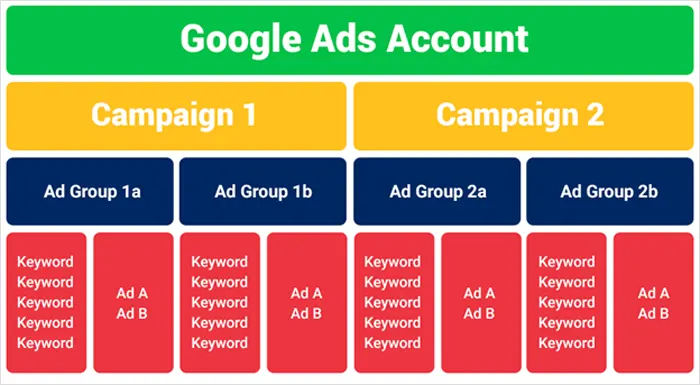


As an advertiser, getting more ad impressions and clicks is a constant battle. Sure, you can pay your way to the top of sponsored search results, but this can get expensive fast and cause your marketing ROI to suffer.
Another way to improve your ad performance is to work on ad relevance (aka keyword relevance). Search engines like Google and Bing will reward you with higher ad placements if your ads are more relevant to user searches.
In this article, we’ll go over what ad relevance is, why it’s important, and six ways you can start improving ad relevance today.
Let’s get started!
Table of Contents
ToggleGoogle defines ad relevance as” how closely your ad matches the intent behind a user’s search.” Bing defines it the same way: “how relevant your ad and landing page are to the customer’s search query or other input.”
Basically, ad relevance is how closely your ad (including keywords and landing pages) matches what users are looking for.
Ad relevance is also one of the three main components of your ad’s Quality Score (along with expected clickthrough rate and landing page experience), which Google uses to give your ads a status of “above average,” “average,” or “below average.”

Source: https://help.ads.microsoft.com/apex/index/3/en-us/50813
To measure ad relevance, Google compares your ads to other ads targeting the same keyword over the last 90 days.
Ad relevance is important for a couple of reasons.
For one, it helps you cater your ads to your target audience. The more relevant your ads are, the more likely users are to click on them and turn into leads that ultimately buy your product or service.
But improving ad relevance also helps you indirectly by lowering your ads’ cost per click (CPC). Let me explain.
When you score higher on search engines’ ad relevance (and overall ad quality) metrics, they will favor your ads in their search engine results pages (SERPs). How? By displaying your ads over (or higher than) other ads.
This means your ads will gain more impressions and clicks, and more clicks for the same budget means a lower cost-per-click (CPC) rate. Basically, it’s getting more bang for your buck.
If that sounds like something you want, here’s how to start making your ads more relevant today:
The first step to making your ads more relevant is to match them with search terms.
Think like a customer. If you were searching for a new pair of men’s running shoes, you might type “buy new men’s running shoes” into Google.
As a consumer, you’d be more likely to click on an ad that said, “shop for new men’s running shoes” than one that said, “buy men’s apparel.”
Why? Because the first ad is much more specific to your actual need, whereas the second is broader and more generic and may not be what you want.
Focusing your ads on long-tail keywords (keywords that are longer but more specific) will not only help you target specific types of buyers but will help you gain more qualified leads.
For example, even if you manage to place an ad for the keyword “buy men’s apparel,” you may attract people looking for things you don’t sell (e.g., men’s ties), and that doesn’t help you or them.
So, target specific keywords and place them upfront in your ads. Search engines bold keywords in search queries, so your ad will stand out more if the relevant keyword is displayed in the ad headline, body, URL, and display path fields.
When it comes to search ads, users are telling you what they’re looking for. So, make sure to deliver by targeting relevant keywords.
Poor ad relevance usually comes from copying ads from one ad group to another without editing or tailoring them.
To ensure your ads stay relevant from one product or service to the next, create multiple ad groups. You can create separate ad groups for different products, buyer personas (segregated by gender, age, location, and other demographics), and more.
As a rule of thumb, you should limit ad groups to about 5 to 20 related keywords. Then create different ads based on these different keyword variations.
The more specific you can make each ad, the more relevant they will be to users.

Source: https://www.adzooma.com/blog/how-to-use-ad-groups-to-boost-success/
Once you’ve targeted different search terms and grouped your ads, it’s important to make sure each ad is as simple as can be.
Write ad copy that can be understood by a third grader. Why? You have a very short amount of time to grab readers’ attention with your ads. So, the simpler an ad is to digest, the more likely someone is to stop and read it.
It may be tempting to try to make your ad clever because you want it to stand out, but the truth is that this rarely works. People on the internet want instant gratification, so if they have to put in the slightest amount of mental work to understand an ad, they’ll give up and move on.
Instead, make your ads clear and direct. Tell users exactly what it is you’re selling without trying to impress them with your words.
Every ad needs a clear call to action (CTA). Without it, your ad isn’t really an ad because it’s not telling people what you want them to do.
CTAs will look different based on what it is you’re advertising. If you want users to buy some men’s running shoes on your website, your CTA might say “buy men’s running shoes now.” If you want users to download your free men’s running ebook, it might read “download free men’s running ebook.”
You get the point. Tell users exactly what you want them to do and exactly what they’ll get by clicking.
Crafting relevant ad copy is half the battle. From there, you also need to make sure the landing page that your ad leads to is relevant.
The job of the landing page is to close the deal. It’s where users actually become leads or customers by signing up for a newsletter or making an online order.
As a result, the landing page needs to match whatever the ad promotes. If the ad promotes men’s running shoes, the landing page better be an eCommerce storefront where users can place an order. If not, you’ll disappoint and lose potential customers because you’re not giving them what they signed up for by clicking the ad.
Landing pages should contain all the same relevant keywords as the ad and exclude non-relevant and missing ones.
It’s also important to design landing pages to be user-friendly. Good UX design could be the difference between gaining a lead or a customer.
Peter Drucker once said, “If you can’t measure it, you can’t improve it.” And the same goes for improving ad relevance.
To measure how well your ads are performing, conduct A/B tests. This means creating two slightly different versions of an ad and then running both to see which performs better on common ad metrics, such as click-through rate (CTR), ad position, number of impressions, and cost per click (CPC).
You can A/B test different ad copy, keywords, ad channels, and more.

Source: https://www.optimizely.com/optimization-glossary/ab-testing/
If you don’t have a dedicated A/B testing software solution, you can always set up custom experiments on Google’s ad platform.
You can also identify poor-performing ads with the help of Google Ads Scripts.
Whatever you do, constantly reevaluate your ads so you can fine-tune their relevance over time.
Not sure you have the time or resources to run your own online ad campaigns? No worries. PPC.co is here to help.
We can help you run top-performing ad campaigns on Google, Facebook, LinkedIn and more. You can be involved every step of the way or sit back and relax and let us handle all the hard work. It’s up to you.
Get in touch today for a free proposal. We look forward to chatting!
Please fill the below form to download the PDF
“*” indicates required fields.
Please fill the below form to download the PDF
“*” indicates required fields.
Please fill the below form to download the PDF
“*” indicates required fields.
Please fill the below form to download the PDF
“*” indicates required fields.
Please fill the below form to download the PDF
“*” indicates required fields.
Please fill the below form to download the PDF
“*” indicates required fields.